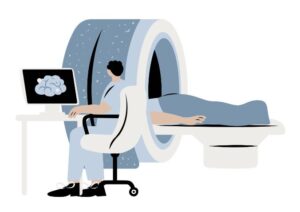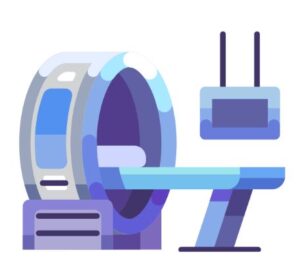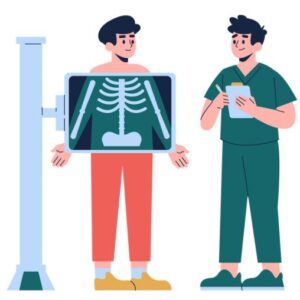Understanding Different Imaging Techniques at Diagnostic Imaging Northwest

Medical imaging is a crucial tool in modern healthcare, providing detailed visuals of the human body’s internal structures and helping in the accurate diagnosis and treatment of various conditions. At Diagnostic Imaging Northwest (DINW) outpatient centers, patients have access to a variety of imaging modalities, each with specific applications and benefits. In this blog post, we’ll explore the differences and uses of MRI, CT scans, X-rays, ultrasounds and mammography to help you better understand what to expect and how these technologies can assist in your healthcare.
Magnetic Resonance Imaging (MRI)
 MRI stands for Magnetic Resonance Imaging. Unlike X-rays and CT scans, MRIs do not use ionizing radiation. Instead, they employ a powerful magnetic field along with radio waves to produce detailed images of organs and tissues. This technique is particularly useful for imaging the brain, spinal cord, nerves, muscles, and tendons. Check out the different types of MRI machines we use!
MRI stands for Magnetic Resonance Imaging. Unlike X-rays and CT scans, MRIs do not use ionizing radiation. Instead, they employ a powerful magnetic field along with radio waves to produce detailed images of organs and tissues. This technique is particularly useful for imaging the brain, spinal cord, nerves, muscles, and tendons. Check out the different types of MRI machines we use!
Uses of MRI:
- Brain Disorders: MRIs can detect brain tumors, cerebral aneurysms, strokes, and chronic neurological conditions like multiple sclerosis.
- Joint and Muscle Disorders: It is excellent for imaging knee and shoulder injuries.
- Cancer Screening: Useful in the detailed assessment of breast cancer when used alongside mammography.
Computed Tomography (CT) Scans
 CT scans, or Computed Tomography scans, use X-ray equipment to create detailed images of the body. It combines several X-ray images taken from different angles and uses computer processing to create cross-sectional images of the bones, blood vessels, and soft tissues inside your body. CT scans are faster than MRIs and can be crucial in emergencies.
CT scans, or Computed Tomography scans, use X-ray equipment to create detailed images of the body. It combines several X-ray images taken from different angles and uses computer processing to create cross-sectional images of the bones, blood vessels, and soft tissues inside your body. CT scans are faster than MRIs and can be crucial in emergencies.
Uses of CT Scans:
- Emergency Diagnoses: Quick to perform, they are used in emergency rooms to diagnose internal injuries and bleeding.
- Cancer Detection: Help determine tumor size, location, and metastasis.
- Guided Procedures: Used during biopsies and surgeries to guide precise decision-making.
X-rays
 X-rays are a type of radiation known as electromagnetic waves. X-ray imaging creates pictures of the inside of your body — the images show different parts in varying shades of black and white. This is because different tissues absorb different amounts of radiation. X-rays are fast, painless, and commonly used.
X-rays are a type of radiation known as electromagnetic waves. X-ray imaging creates pictures of the inside of your body — the images show different parts in varying shades of black and white. This is because different tissues absorb different amounts of radiation. X-rays are fast, painless, and commonly used.
Uses of X-rays:
- Bone Imaging: Commonly used to detect bone fractures and joint abnormalities.
- Dental Assessment: Helps in diagnosing tooth decay and periodontal disease.
- Chest X-rays: Can spot lung conditions, heart size, and major blood vessels.
Ultrasound
 Ultrasound imaging, also known as sonography, uses high-frequency sound waves to produce images of structures within your body. The images can provide valuable information for diagnosing and treating a variety of diseases and conditions.
Ultrasound imaging, also known as sonography, uses high-frequency sound waves to produce images of structures within your body. The images can provide valuable information for diagnosing and treating a variety of diseases and conditions.
Uses of Ultrasound:
- Pregnancy: Monitors the development of the fetus and checks for congenital anomalies.
- Abdominal Scans: Helps in assessing organs like the gallbladder, liver, and kidneys.
- Heart Conditions: Echocardiograms are special types of ultrasounds that look at the heart and its function.
Mammography
 Mammography is a specialized medical imaging technique used to examine breast tissue for signs of abnormalities, including breast cancer. At DINW, we offer 3D mammography, or digital breast tomosynthesis, which provides a more detailed and clearer view compared to traditional 2D mammography.
Mammography is a specialized medical imaging technique used to examine breast tissue for signs of abnormalities, including breast cancer. At DINW, we offer 3D mammography, or digital breast tomosynthesis, which provides a more detailed and clearer view compared to traditional 2D mammography.
How 3D Mammography Works:
3D mammography takes multiple X-ray pictures of each breast from different angles and uses computer software to reconstruct these images into a series of thin slices. This process allows radiologists to view the breast tissue layer by layer, like pages in a book, significantly reducing the impact of overlapping breast tissue, which can sometimes obscure or mimic malignancies in 2D images.
Uses of 3D Mammography:
- Early Detection of Breast Cancer: Increases the detection rate of small breast cancers that may not be visible on traditional mammograms.
- Reducing False Positives: Lower the chance of false positive findings, which can lead to fewer unnecessary biopsies and anxiety.
- Dense Breasts: Particularly beneficial for women with dense breast tissue, where overlapping layers can hide cancers.
Each imaging technique offered at DINW has its unique strengths and is chosen based on the specific medical situation and the part of the body being examined. Understanding these different imaging techniques can help alleviate any apprehension you might have about undergoing them and allow you to appreciate how they contribute to your overall healthcare management. If you have questions about a particular imaging test, it’s always best to discuss with your healthcare provider who can provide guidance tailored to your personal health needs.
Learn more about Our Services offered at Diagnostic Imaging Northwest.
